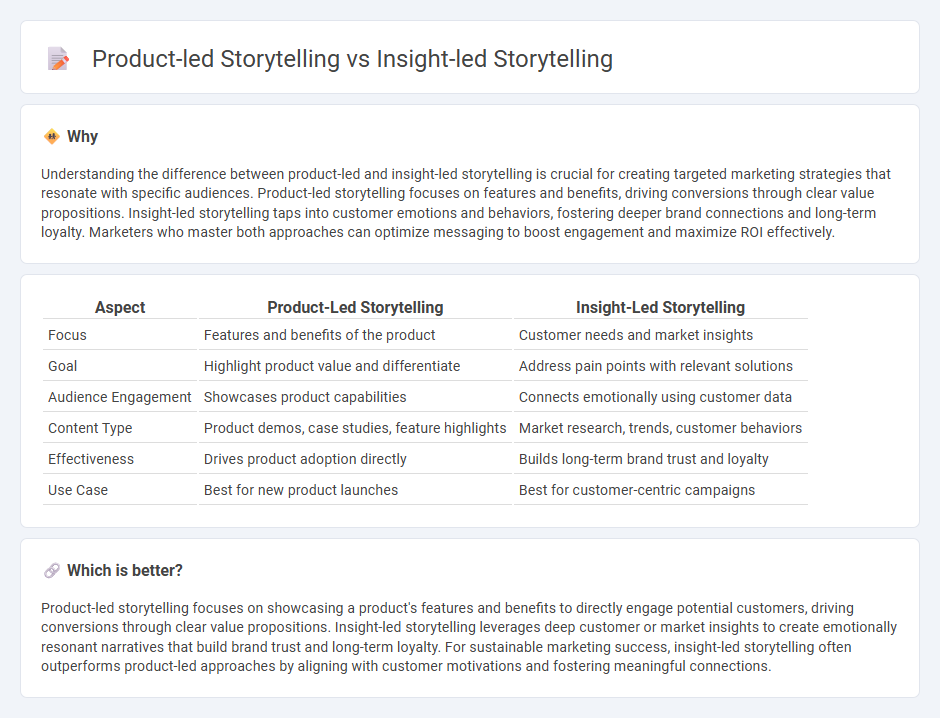
Product-led storytelling focuses on showcasing the features and benefits of a product to engage customers by demonstrating value and functionality. Insight-led storytelling emphasizes understanding customer behaviors and market trends to craft narratives that resonate on a deeper emotional or psychological level. Explore the distinctions between these storytelling approaches to optimize your marketing strategy.
Why it is important
Understanding the difference between product-led and insight-led storytelling is crucial for creating targeted marketing strategies that resonate with specific audiences. Product-led storytelling focuses on features and benefits, driving conversions through clear value propositions. Insight-led storytelling taps into customer emotions and behaviors, fostering deeper brand connections and long-term loyalty. Marketers who master both approaches can optimize messaging to boost engagement and maximize ROI effectively.
Comparison Table
| Aspect | Product-Led Storytelling | Insight-Led Storytelling |
|---|---|---|
| Focus | Features and benefits of the product | Customer needs and market insights |
| Goal | Highlight product value and differentiate | Address pain points with relevant solutions |
| Audience Engagement | Showcases product capabilities | Connects emotionally using customer data |
| Content Type | Product demos, case studies, feature highlights | Market research, trends, customer behaviors |
| Effectiveness | Drives product adoption directly | Builds long-term brand trust and loyalty |
| Use Case | Best for new product launches | Best for customer-centric campaigns |
Which is better?
Product-led storytelling focuses on showcasing a product's features and benefits to directly engage potential customers, driving conversions through clear value propositions. Insight-led storytelling leverages deep customer or market insights to create emotionally resonant narratives that build brand trust and long-term loyalty. For sustainable marketing success, insight-led storytelling often outperforms product-led approaches by aligning with customer motivations and fostering meaningful connections.
Connection
Product-led storytelling centers on showcasing a product's features and benefits through compelling narratives, while insight-led storytelling leverages deep customer data and market insights to tailor these narratives effectively. Combining product knowledge with consumer insights enhances the relevance and emotional impact of marketing campaigns, driving higher engagement and conversion rates. This integrated approach enables brands to craft stories that resonate authentically, aligning product value with customer needs and preferences.
Key Terms
Consumer Insights
Insight-led storytelling centers on deep consumer insights to craft narratives that resonate emotionally and address genuine needs, driving engagement through relevance and authenticity. Product-led storytelling emphasizes showcasing product features and innovations, often highlighting technical benefits and competitive advantages to attract customers. Discover how leveraging consumer insights can transform your storytelling strategy and boost brand loyalty.
Emotional Connection
Insight-led storytelling prioritizes deep audience understanding, using data-driven insights to craft narratives that resonate emotionally and build trust. Product-led storytelling centers on showcasing features and benefits, often appealing to logic more than feelings. Explore how blending both approaches can maximize emotional connection and brand loyalty.
Product Features
Product-led storytelling emphasizes detailed product features, highlighting functionality and technical specifications to demonstrate value to users. Insight-led storytelling centers on understanding customer needs and uses those insights to craft narratives that connect emotionally and solve problems effectively. Explore how blending both approaches can enhance your brand's storytelling strategy.
Source and External Links
How strategic, insights-led storytelling can fuel your talent attraction - This resource outlines how data-driven insights shape messaging to craft narratives that truly resonate, enhancing employer branding by engaging both head and heart through strategic insight and impactful storytelling.
Insight-led Content: The Engagement Trap - The Work Crowd - Insight-led storytelling involves using deep business intelligence to not only inform content creation but to ensure narratives align with audience needs and tone, driving meaningful engagement beyond mere views or clicks.
5 Tips For Building an Insight-Led Culture - Stravito - Building an insight-led culture emphasizes sharing actionable, accessible insights that foster collaboration and curiosity, helping organizations move from data delivery to storytelling that drives better business questions and decisions.
 dowidth.com
dowidth.com